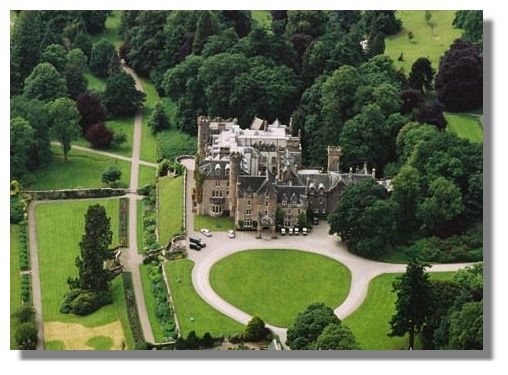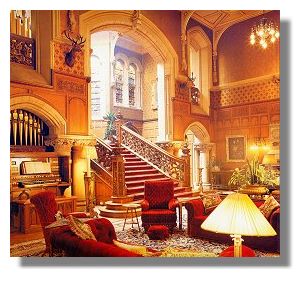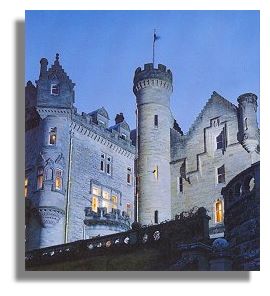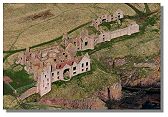
Skibo Castle Graphic copyright © Scotavia Images
Scottish Castles Photo Library
- Skibo Castle, Dornoch

Early History
There is mention in 1275 of a castle at Skibo, a few miles from Dornoch, when the Bishop of Caithness and the Earl of Sutherland are recorded as having a dispute over ownership. Clearly the church won and the estate and castle belonged to the Bishops of Caithness for several centuries. The Reformation then put an end to their tenure and in 1565 the Bishop assigned it to a John Grey and his successors. James Graham, 1st Marquis of Montrose, who had supported King Charles I in the Civil War in the 1640s, was imprisoned in Skibo after he had been betrayed at Ardvreck Castle. Skibo's owner at that time, Robert Gray, was fined after his wife had hit one of the soldiers guarding Montrose with a leg of meat!
The estate then passed to the Dowalls in 1776 after the death of a later Robert Grey and then the Dempsters of Dunnichen in 1786. The castle was rebuilt at that time - the present castle (seen in the old print shown here and in the other illustrations) was built on the same site.
Andrew Carnegie Arrives

Andrew Carnegie was born in Dunfermline, Fife in 1835, the son of a weaver. At the age of 12 he travelled with his family to the United States, the land of freedom and promise. By the time he was 24 Carnegie had become a superintendent Pennsylvania Railroad and then invested in oil and steel. When he sold out to the US Steel Corporation in 1901, for $250 million, he was one of the richest men in the world. He had married a young American woman, Louise Whitfield, and brought her to Scotland for their honeymoon. They visited Scotland regularly over the next ten years. In 1897 Louise gave birth to their first and only child. Carnegie was overjoyed at becoming a father and made an immediate decision. "Margaret must have a Scottish home!"Carnegie was not at all convinced about Skibo when it was suggested as it was in a dilapidated state, but driving up the beech-lined avenue Carnegie was captivated. Skibo would be his Faery Glen, his own place of peace. The purchase price was £85,000 and over the next few years a further £2 million was spent, creating a majestic baronial mansion house featuring towers, turrets and battlements, with one hundred rooms. The very latest domestic appliances and modern technology from America were installed including up to date bathrooms and plumbing systems, an electric lift (installed personally by Mr. Otis) and a glass roofed swimming pavilion, beside the loch, with a full length, Olympic size heated indoor pool. There was a vast estate of 20,000 acres on the shores of Loch Evelix and the Dornoch Firth. Louise was particularly interested in planning a beautiful garden and no expense was spared to create a series of rolling lawns, herbaceous borders, orchards, woodland walks, greenhouses, ponds with, of course, a waterfall, all in true Scottish country house fashion. For the next twenty years, until his death in 1919, he enjoyed the happiest years of his life at Skibo, which he described as "Heaven on Earth".
Carnegie Club at Skibo Castle

After Carnegie's death his wife and daughter returned to the United States but came back each summer. Eventually, however, it was no longer required. Selling the property became a problem, as it began to deteriorate. One Friday in July, 1990 Peter de Savary, the wealthy hotelier, property developer, yachtsman and business entrepreneur decided to visit Skibo to see a painting which was featured as part of the contents for sale. By the following Wednesday, he not only bought the painting, he had purchased the entire castle and an estate of 7,000 acres for £ 10 million. Like Carnegie before him, de Savary was utterly enchanted by Skibo.Over the next three years major restoration, rather than a radical renovation, got underway at a cost of around £30 million. Peter de Savary was an experienced and astute businessman and he knew that it that it was not only right but also far more beneficial to preserve Skibo Castle as it was. He would not develop a `museum` in Carnegie's honour, but a lived-in country house Highland estate which would be visited once again by the great and good, rich and famous, to recreate the atmosphere of his life at Skibo.
The Carnegie Club at Skibo Castle is now a private residential Golf and Sporting Club with an international membership limited by invitation. There are currently 650 members, with 40% from the United States, 40% from the UK and 20% from 29 countries around the world. The good news is that non-members may visit once, at a guest charge, to enjoy the superb surroundings of the Castle and the leisure facilities of the Club and have the opportunity to consider - and be considered - for membership.
Note: The photo of Skibo Castle at the top of this page is courtesy of Scotavia Images who provide a quality aerial photography service for Scotland. Prints from their large online gallery are available for purchase. If you have ancestors with a Scottish Highland origin, they can provide an aerial view of the area they came from! The other graphics on this page were supplied by the Carnegie Club.
Return to the Castles Photo Library Index
or go to the next castle:  Slains Castle.
Slains Castle.
Where else would you like to go in Scotland?
Where else would you like to go in Scotland?

